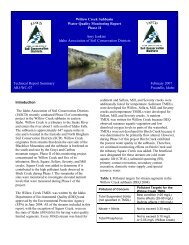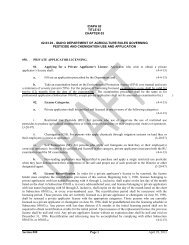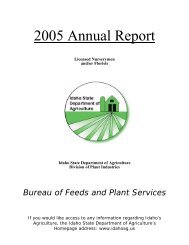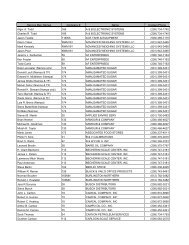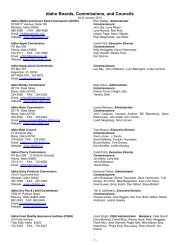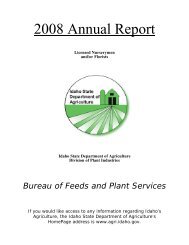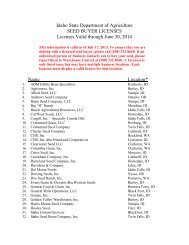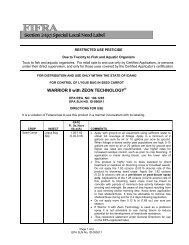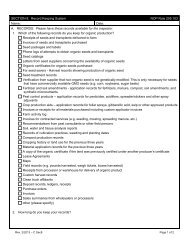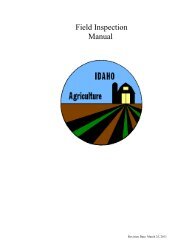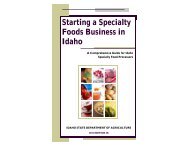2008 Statewide Strategic Plan for Eurasian Watermilfoil in Idaho
2008 Statewide Strategic Plan for Eurasian Watermilfoil in Idaho
2008 Statewide Strategic Plan for Eurasian Watermilfoil in Idaho
You also want an ePaper? Increase the reach of your titles
YUMPU automatically turns print PDFs into web optimized ePapers that Google loves.
C. Effect of sediment on efficacy of benthic barriers as a control measure <strong>for</strong><br />
<strong>Eurasian</strong> watermilfoil<br />
A study was established <strong>in</strong> a walk-<strong>in</strong> growth chamber at the University of <strong>Idaho</strong> <strong>in</strong><br />
2006 to evaluate the effect of sediment deposition on <strong>Eurasian</strong> watermilfoil<br />
establishment and growth. The experimental design of the study was a<br />
randomized complete block design with five sediment depth treatments and four<br />
replications. Typar® spun geotextile fabric was fitted to 4.8 cm diameter PVC pipe<br />
sections with heights rang<strong>in</strong>g from 0.5 to 5 cm. Sediment collected from Lake<br />
Coeur d’Alene near Plummer, <strong>Idaho</strong> was placed with<strong>in</strong> the r<strong>in</strong>gs over the<br />
geotextile fabric at depths of 0, 2, 3, 4, and 5 cm and the r<strong>in</strong>gs were placed <strong>in</strong><br />
aquaria filled with water treated with an appropriate culture solution. A 10 cm<br />
apical shoot section of <strong>Eurasian</strong> watermilfoil was placed on the surface of the<br />
sediment or fabric (0 cm sediment) to simulate naturally occurr<strong>in</strong>g vegetative<br />
reproduction of <strong>Eurasian</strong> watermilfoil. Four weeks after plant<strong>in</strong>g, shoot and root<br />
biomass was harvested, dried at 70 o C <strong>for</strong> 72 hours, and weighed. A statistical<br />
analysis was conducted to determ<strong>in</strong>e the effects of sediment depth on above<br />
sediment plant biomass production and root biomass production. The 1-3 cm<br />
sediment depth shoot and root biomass were not different from the control (0<br />
sediment), <strong>in</strong>dicat<strong>in</strong>g the plant material was able to draw nutrients from the water<br />
without establish<strong>in</strong>g on the fabric barrier material. At sediment depths of 4 and 5<br />
cm, root and shoot biomass <strong>in</strong>creased, <strong>in</strong>dicat<strong>in</strong>g the plant’s ability to establish<br />
and draw nutrients from the sediment. Based on the growth chamber study,<br />
sediment deposition of 4 cm or greater over benthic barrier treatments would<br />
enable reestablishment of <strong>Eurasian</strong> watermilfoil, and should be removed.<br />
D. Biocontrol Feasibility Study<br />
Note: the follow<strong>in</strong>g section was taken directly from Matthew J. W. Cock, Hariet L.<br />
H<strong>in</strong>z, Gitta Grosskopf, and Patrick Häfliger (2006) Development of a biological<br />
control program <strong>for</strong> <strong>Eurasian</strong> watermilfoil (Myriophyllum spicatum) CABI Europe-<br />
Switzerland, unpubl. Report prepared <strong>for</strong> U.S. Army Corps of Eng<strong>in</strong>eers,<br />
Wash<strong>in</strong>gton, DC 20314-1000. 27pp.<br />
A thorough survey of the European literature was carried out at CABI Europe -<br />
Switzerland, complemented by library visits and contacts with taxonomists, and<br />
the Russian literature by CABI collaborator Dr. Margarita Dolgovskaya (Russian<br />
Academy of Sciences, Zoological Institute, St Petersburg, Russia). The European<br />
literature survey revealed 14 additions to the exist<strong>in</strong>g lists compiled by Ghani et al.<br />
(1970) <strong>for</strong> Pakistan and Bangladesh, Buck<strong>in</strong>gham (1998) <strong>for</strong> Ch<strong>in</strong>a, Japan, Korea,<br />
and Spencer and Lekic (1974) <strong>for</strong> Yugoslavia. In total, 44 phytophagous <strong>in</strong>sects<br />
have been associated with Myriophyllum spp. <strong>in</strong> Eurasia. The majority are<br />
Lepidoptera (n=12) and weevils (beetles <strong>in</strong> the family Curculionidae n=15). The<br />
latter is especially rich <strong>in</strong> aquatic weevils <strong>in</strong> the genus Bagous (n=6). Most <strong>in</strong>sects<br />
are recorded as polyphagous, i.e. feed<strong>in</strong>g on plants <strong>in</strong> different families. However,<br />
ten species are recorded to only feed on Myriopyllum spp. or the <strong>in</strong>dication of<br />
other host plants needs to be verified by tests. There is no obvious pattern as to<br />
which region the most specialized phytophagous <strong>in</strong>sect species can be found.<br />
44



